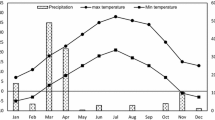Abstract
Percentages of linoleic, oleic and stearic acids present significant differences between growing areas, whereas palmitic acid content remains practically constant, or at least presents no significant relation to the growing area. Nevertheless, palmitic acid appears to follow a pattern that relates its content to the total content of the other three major fatty acids. Seeds grown in the northern part of Spain presented a higher linoleic content than seeds grown in the South, which is in agreement with the general theory found in prior studies. Although there is an inverse correlation between oleic and linoleic content, we have found that the total content of both is neither constant nor independent of temperature, and increases when temperature and oleic acid increase. However, stearic content increases when the combination of linoleic and oleic acid decreases, suggesting a total constant value for the combination of these three acids. The average temperature of the are during development of the seed and the local climatic conditions have the greatest influence over fatty acid composition, while the seed variety presents limited influence.
Similar content being viewed by others
References
Kinman, M.L., and F.R. Earle,Crop. Sci., 4:417 (1964).
Putt, E.D., B.M. Craig and R.B. Carson,J. Am. Oil Chem. Soc. 46:126 (1969).
Canvin, D.T.,Can. J. Botany 43:63 (1965).
Grindley, D.N.,J. Sci. Food Agric. 3:82 (1952).
Kinman, M.L.,J. Am. Oil. Chem. Soc. 49:36 (1972).
Official Methods and Recommended Practices of the American Oil Chemists' Society, R.O. Walker, ed., American Oil Chemists' Society, Champaign, IL, 1980.
, E.M. Sallee, ed., American Oil Chemists' Society, Champaign, IL, 1970.
Cummins, D.G., J.E. Marion, J.P. Craigmiles and R.E. Burns,J. Am. Oil Chem. Soc. 44:581 (1967).
Earle, F.R., C.H. Van Etten, T.F. Clark and I.A. Wolff,45:876 (1968).
Robertson, J.A., J.K. Thomas and Donald Burdick,J. of Food Science 36:873 (1971).
Robertson, J.A.,J. Am. Oil Chem. Soc. 49:239 (1972).
McWilliam, J.R., H.C. Harris and W.K. Mason,Proceedings of the VII International Sunflower Conference, Krasnodar, U.S.S.R., July, 1976.
Rodrigues Pereira, A.S., 8thInternational Sunflower Conference, Minneapolis, MN, July, 1978.
Harris, P., and A.T. James,Biochim. Biophys. Acta 187:13 (1969).
Robertson, J.A., G.W. Chapman, Jr. and R.L. Wilson, Jr.,J. Am. Oil Chem. Soc. 55:266 (1978).
Izzo, R., C. Pardossi and G. Lotti,Rev. Ital. Sostance Grasse, 53:71 (1976).
Zimmerman, D.C., and G.N. Fick,J. Am. Oil Chem. Soc. 50:273 (1973).
Morrison III, W. Herbert,60:1013 (1983).
Author information
Authors and Affiliations
About this article
Cite this article
Lajara, J.R., Diaz, U. & Quidiello, R.D. Definite influence of location and climatic conditions on the fatty acid composition of sunflower seed oil. J Am Oil Chem Soc 67, 618–623 (1990). https://doi.org/10.1007/BF02540410
Received:
Accepted:
Issue Date:
DOI: https://doi.org/10.1007/BF02540410




